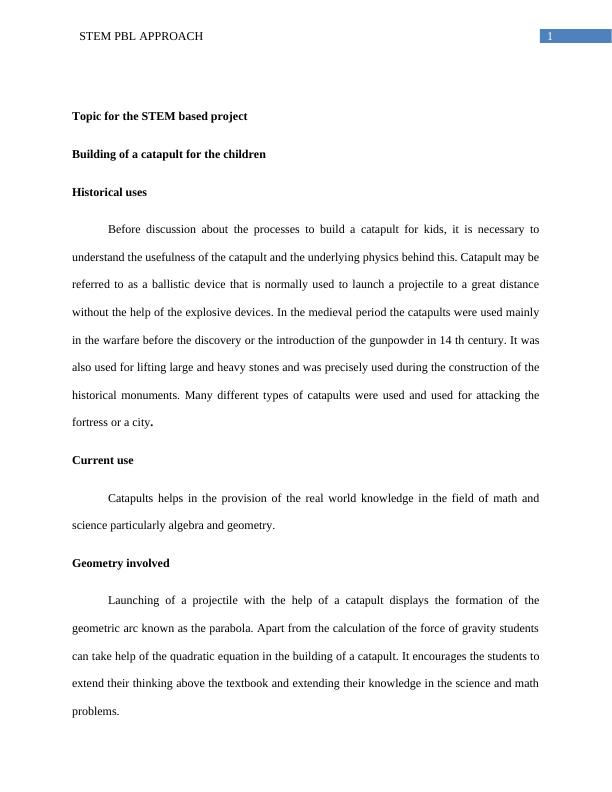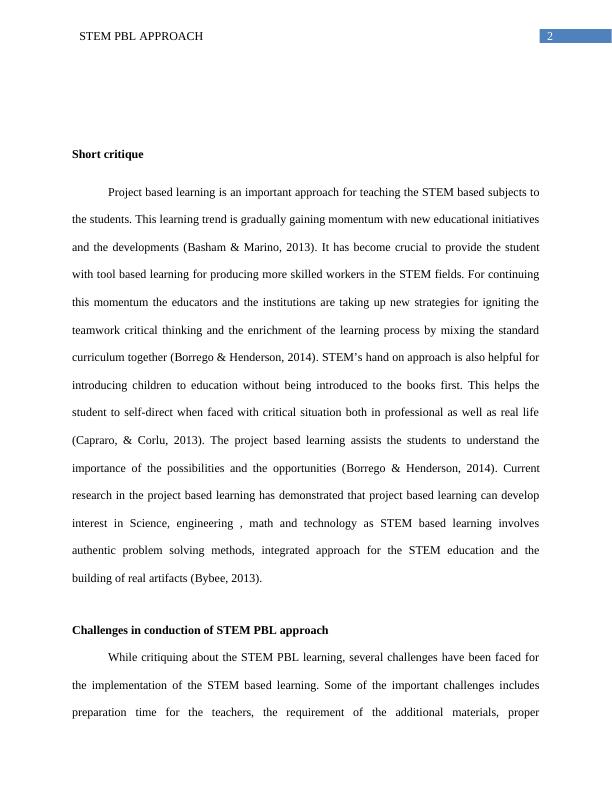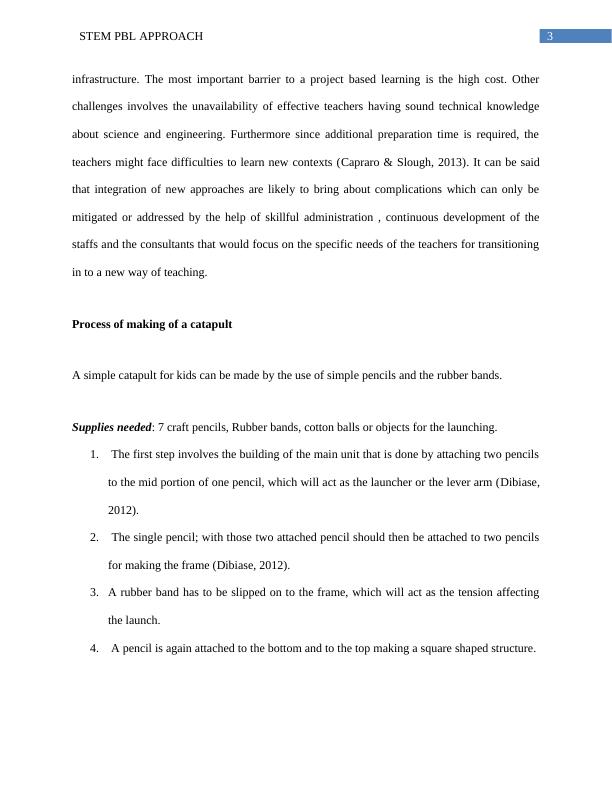STEM PBL Approach: Building a Catapult for Children
Added on 2023-06-11
15 Pages3301 Words212 Views
Running head: STEM PBL APPROACH
STEM PBL APPROACH
Name of the Student
Name of the university
Author’s note
STEM PBL APPROACH
Name of the Student
Name of the university
Author’s note

1STEM PBL APPROACH
Topic for the STEM based project
Building of a catapult for the children
Historical uses
Before discussion about the processes to build a catapult for kids, it is necessary to
understand the usefulness of the catapult and the underlying physics behind this. Catapult may be
referred to as a ballistic device that is normally used to launch a projectile to a great distance
without the help of the explosive devices. In the medieval period the catapults were used mainly
in the warfare before the discovery or the introduction of the gunpowder in 14 th century. It was
also used for lifting large and heavy stones and was precisely used during the construction of the
historical monuments. Many different types of catapults were used and used for attacking the
fortress or a city.
Current use
Catapults helps in the provision of the real world knowledge in the field of math and
science particularly algebra and geometry.
Geometry involved
Launching of a projectile with the help of a catapult displays the formation of the
geometric arc known as the parabola. Apart from the calculation of the force of gravity students
can take help of the quadratic equation in the building of a catapult. It encourages the students to
extend their thinking above the textbook and extending their knowledge in the science and math
problems.
Topic for the STEM based project
Building of a catapult for the children
Historical uses
Before discussion about the processes to build a catapult for kids, it is necessary to
understand the usefulness of the catapult and the underlying physics behind this. Catapult may be
referred to as a ballistic device that is normally used to launch a projectile to a great distance
without the help of the explosive devices. In the medieval period the catapults were used mainly
in the warfare before the discovery or the introduction of the gunpowder in 14 th century. It was
also used for lifting large and heavy stones and was precisely used during the construction of the
historical monuments. Many different types of catapults were used and used for attacking the
fortress or a city.
Current use
Catapults helps in the provision of the real world knowledge in the field of math and
science particularly algebra and geometry.
Geometry involved
Launching of a projectile with the help of a catapult displays the formation of the
geometric arc known as the parabola. Apart from the calculation of the force of gravity students
can take help of the quadratic equation in the building of a catapult. It encourages the students to
extend their thinking above the textbook and extending their knowledge in the science and math
problems.

2STEM PBL APPROACH
Short critique
Project based learning is an important approach for teaching the STEM based subjects to
the students. This learning trend is gradually gaining momentum with new educational initiatives
and the developments (Basham & Marino, 2013). It has become crucial to provide the student
with tool based learning for producing more skilled workers in the STEM fields. For continuing
this momentum the educators and the institutions are taking up new strategies for igniting the
teamwork critical thinking and the enrichment of the learning process by mixing the standard
curriculum together (Borrego & Henderson, 2014). STEM’s hand on approach is also helpful for
introducing children to education without being introduced to the books first. This helps the
student to self-direct when faced with critical situation both in professional as well as real life
(Capraro, & Corlu, 2013). The project based learning assists the students to understand the
importance of the possibilities and the opportunities (Borrego & Henderson, 2014). Current
research in the project based learning has demonstrated that project based learning can develop
interest in Science, engineering , math and technology as STEM based learning involves
authentic problem solving methods, integrated approach for the STEM education and the
building of real artifacts (Bybee, 2013).
Challenges in conduction of STEM PBL approach
While critiquing about the STEM PBL learning, several challenges have been faced for
the implementation of the STEM based learning. Some of the important challenges includes
preparation time for the teachers, the requirement of the additional materials, proper
Short critique
Project based learning is an important approach for teaching the STEM based subjects to
the students. This learning trend is gradually gaining momentum with new educational initiatives
and the developments (Basham & Marino, 2013). It has become crucial to provide the student
with tool based learning for producing more skilled workers in the STEM fields. For continuing
this momentum the educators and the institutions are taking up new strategies for igniting the
teamwork critical thinking and the enrichment of the learning process by mixing the standard
curriculum together (Borrego & Henderson, 2014). STEM’s hand on approach is also helpful for
introducing children to education without being introduced to the books first. This helps the
student to self-direct when faced with critical situation both in professional as well as real life
(Capraro, & Corlu, 2013). The project based learning assists the students to understand the
importance of the possibilities and the opportunities (Borrego & Henderson, 2014). Current
research in the project based learning has demonstrated that project based learning can develop
interest in Science, engineering , math and technology as STEM based learning involves
authentic problem solving methods, integrated approach for the STEM education and the
building of real artifacts (Bybee, 2013).
Challenges in conduction of STEM PBL approach
While critiquing about the STEM PBL learning, several challenges have been faced for
the implementation of the STEM based learning. Some of the important challenges includes
preparation time for the teachers, the requirement of the additional materials, proper

3STEM PBL APPROACH
infrastructure. The most important barrier to a project based learning is the high cost. Other
challenges involves the unavailability of effective teachers having sound technical knowledge
about science and engineering. Furthermore since additional preparation time is required, the
teachers might face difficulties to learn new contexts (Capraro & Slough, 2013). It can be said
that integration of new approaches are likely to bring about complications which can only be
mitigated or addressed by the help of skillful administration , continuous development of the
staffs and the consultants that would focus on the specific needs of the teachers for transitioning
in to a new way of teaching.
Process of making of a catapult
A simple catapult for kids can be made by the use of simple pencils and the rubber bands.
Supplies needed: 7 craft pencils, Rubber bands, cotton balls or objects for the launching.
1. The first step involves the building of the main unit that is done by attaching two pencils
to the mid portion of one pencil, which will act as the launcher or the lever arm (Dibiase,
2012).
2. The single pencil; with those two attached pencil should then be attached to two pencils
for making the frame (Dibiase, 2012).
3. A rubber band has to be slipped on to the frame, which will act as the tension affecting
the launch.
4. A pencil is again attached to the bottom and to the top making a square shaped structure.
infrastructure. The most important barrier to a project based learning is the high cost. Other
challenges involves the unavailability of effective teachers having sound technical knowledge
about science and engineering. Furthermore since additional preparation time is required, the
teachers might face difficulties to learn new contexts (Capraro & Slough, 2013). It can be said
that integration of new approaches are likely to bring about complications which can only be
mitigated or addressed by the help of skillful administration , continuous development of the
staffs and the consultants that would focus on the specific needs of the teachers for transitioning
in to a new way of teaching.
Process of making of a catapult
A simple catapult for kids can be made by the use of simple pencils and the rubber bands.
Supplies needed: 7 craft pencils, Rubber bands, cotton balls or objects for the launching.
1. The first step involves the building of the main unit that is done by attaching two pencils
to the mid portion of one pencil, which will act as the launcher or the lever arm (Dibiase,
2012).
2. The single pencil; with those two attached pencil should then be attached to two pencils
for making the frame (Dibiase, 2012).
3. A rubber band has to be slipped on to the frame, which will act as the tension affecting
the launch.
4. A pencil is again attached to the bottom and to the top making a square shaped structure.

End of preview
Want to access all the pages? Upload your documents or become a member.
Related Documents
Education Pedagogy: Case Study of Mrs. Edwardlg...
|7
|1582
|26
Curriculum of Science | Essaylg...
|8
|3191
|63
Reading Strategies - Physical Education activitieslg...
|3
|644
|19
The Influence of English Language on Mathematics Performance in TVET Collegeslg...
|6
|1696
|479
